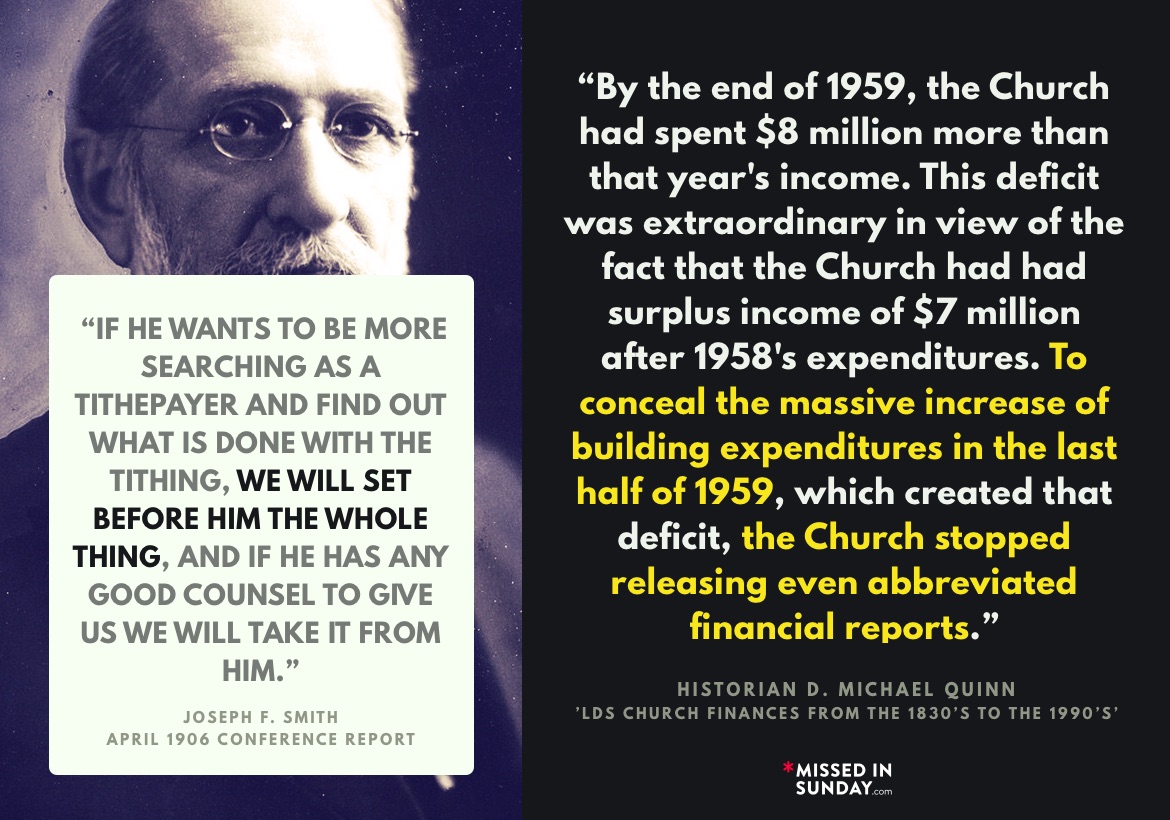Transparency
FinancesOctober 1905 Conference Report, Prophet Joseph F. Smith, Pg. 5: 1
“I want to say further to the Saints, that your brethren to whom you have entrusted the care and management of the finances of the Church stand ready and willing, any moment,’ to answer to YOU — to Latter-day Saints, to tithepayers, to those who are in the faith of the Gospel — for our stewardship. We can give you an account of our doings to the last senine; and I defy any man on earth to point his finger to a dollar that is willfully wasted, or stolen by the servants of God. The tithing books are kept as accurately and as perfectly as any books kept in any bank. Every man that pays a dollar tithing gets his credit on the books; and if he wants to see that his credit is there he can go and see for himself. But we do not propose to open our books and show your accounts to every Tom, Dick and Harry in the land that never did pay any tithing. We do not propose to do that, if we can help it. But you Latter-day Saints who pay your tithes and your offerings, if you want to see for yourselves, that you may be eye and ear witnesses, the books are open to you, and you can come and examine your accounts any business day you want.”
April 1906 Conference Report, Prophet Joseph F. Smith, Pg. 6,7: 2
“I want to say to the Latter-day Saints that the year 1905 has been the banner year for the tithings of the people. You can put that down in your memorandum books, and remember it. Never in the history of the Church of Jesus Christ of Latter-day Saints have the people contributed as much tithing as they did in 1905. And yet they have not done anything more than their duty; in fact, there are a great many Latter-day Saints that have not done their duty, as the books will show.
In this connection I may say that a most thorough and searching auditation of the books of the Trustee-in-Trust, the books of the Presiding Bishopric, and the books of the Deseret News Company, has been made by the auditors that were appointed and sustained at our last conference. Before the conclusion of this conference we will read you their report, and I believe you will be perfectly satisfied with it. The man that complains about not knowing what is done with the tithing, in ninety-nine cases out of a hundred is the man who has no credit on the books of the Church for paying tithing. We do not care to exhibit the books of the Church to such carpers and to that class of people. But there is not a tithepayer in the Church that cannot go to the Presiding Bishop’s Office, or to the office of the Trustee-in-Trust, if he desires, and find his account, and see to it that every dollar he has given to the Lord for tithing is credited to him. Then, if he wants to be more searching as a tithepayer and find out what is done with the tithing, we will set before him the whole thing, and if he has any good counsel to give us we will take it from him. But we will not — because we do not have to, and it is not the business of the world to require it open our books to the world, unless we wish to. We are not ashamed of them. We are not afraid for them to be inspected. They are honest and straight; and there is not a man in the world that will look at them, but will say so, if he is honest himself.”
Excerpt from ’LDS Church Finances from the 1830’s to the 1990’s’, by historian D. Michael Quinn: 3
“The combination of bad financial investments, declines in Church businesses, and the Great Depression once again pushed the LDS church into deficit spending. First Counselor J. Reuben Clark announced to general conferences that the Church had spending deficits amounting to $100,000 in 1937 and to nearly $900,000 in 1938. In President Clark’s view, voluntary disclosure of regrettable deficits was a way to encourage greater austerity on the part of the leaders at headquarters and elsewhere. During the 1940s Clark allowed the church to spend only 27% of its annual tithing revenues.
Twenty years later, the First Presidency’s deficit spending stopped the practice of releasing detailed financial reports at April general conferences, a regular practice since 1915. During a few months in mid-1956, the Church lost a million dollars of tithing funds invested in municipal government bonds. Yet later that year, the First Presidency committed two thirds of Church income to continued investment in municipal bonds. ’08 The next annual financial report gave fewer details about expenditures of Church funds, and the Church published its last financial report in April 1959.
By the end of 1959, the Church had spent $8 million more than that year’s income. This deficit was extraordinary in view of the fact that the Church had had surplus income of $7 million after 1958’s expenditures. To conceal the massive increase of building expenditures in the last half of 1959, which created that deficit, the Church stopped releasing even abbreviated financial reports. At the close of 1961, Apostle Harold B. Lee expressed “my stubborn resistance to the principle of ‘deficit spending,’ supposedly justified in the hope of increasing the tithing of the Church to cover the deficit,” to no avail.”
References
| 1 | October 1905 Conference Report – https://archive.org/details/conferencereport1905sa |
|---|---|
| 2 | April 1906 Conference Report – https://archive.org/details/conferencereport1906a |
| 3 | ’LDS Church Finances from the 1830’s to the 1990’s’, by historian D. Michael Quinn – https://www.sunstonemagazine.com/pdf/102-17-29.pdf |

